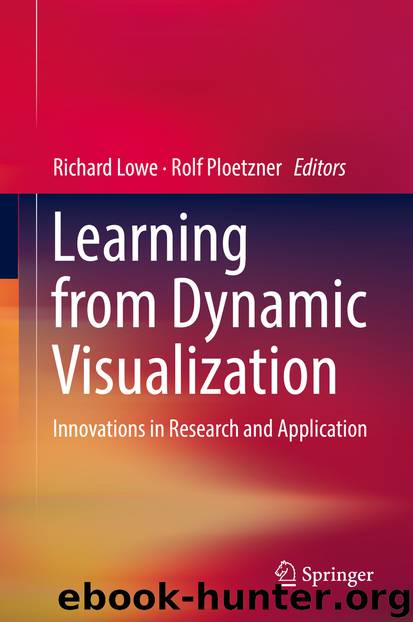Learning from Dynamic Visualization by Richard Lowe & Rolf Ploetzner

Author:Richard Lowe & Rolf Ploetzner
Language: eng
Format: epub
Publisher: Springer International Publishing, Cham
In contrast with the previous earthworm example, the ant’s body undergoes no visible transformations (due to its rigid exoskeleton). However, its segmented legs do perform complex and subtle translational motions during locomotion. These individual motions are both tightly coordinated and hierarchically organized into overarching patterns of movement. For a proper understanding of ant locomotion, a learner must develop a sophisticated internal representation that is multilayered with respect to both space and time. In order to assess the quality of the mental model the learner develops from an ant locomotion animation, the demonstration materials and procedure must be capable of capturing the extent to which this level of sophistication is present.
Figure 8.13 shows the 3D manipulable model used to investigate learning from animations of ant locomotion (Lowe et al. 2014). The model was designed as a reasonably faithful representation of the ant’s jointed legs with respect to the movements that participants can perform with them. However, other aspects of the ant’s body that are essentially irrelevant to locomotion (such as the head and abdomen) were omitted. Further, the shapes of the thorax and legs are greatly simplified since they are of no real consequence in this context. The fact that this model needed to be 3D in order to permit proper demonstration of ant locomotion raised design issues not encountered with the previous 2D examples discussed above. In particular, there were the practical challenges of (i) minimizing constraints on how the legs could be moved so learner demonstrations mainly reflected knowledge acquired from the animation, and yet (ii) maximizing stability of the interim configurations generated by the participants during the course of their demonstrations so that it was physically feasible for them to perform manipulations of the model that were suitably informative. Balancing these two competing aspects was addressed by (i) using a small support beneath the thorax section to keep it sufficiently raised for the legs to adopt a ‘natural’ elevated position relative to the walking surface (rather than being incorrectly splayed out flat across the surface), and (ii) attaching small beads of sticky putty to the ends of the legs in contact with the floor so that once the participant had placed each leg in position, its configuration would be maintained after it was released. Both of these provisions were essentially preventive measures take to avoid disruptive effects of gravity on the demonstration. As would be expected, the presence of these features required participants to receive preliminary training about how to manipulate the model in order to make the best of their demonstrations. Figure 8.14 is a frame from a video of this manipulation in progress. The animation shows that in reality, an ant’s six legs all act together, each with its own distinctive and complex pattern of motion. As with the earlier examples, it would be physically impossible for a participant to demonstrate this array of simultaneous movements as they actually occur. Consequently, participants were instructed to partition their demonstrations into tractable chunks and complement them with verbal and gestural indications of the true temporal structure shown in the animation.
Download
This site does not store any files on its server. We only index and link to content provided by other sites. Please contact the content providers to delete copyright contents if any and email us, we'll remove relevant links or contents immediately.
The Art of Coaching Workbook by Elena Aguilar(50737)
Trainspotting by Irvine Welsh(21407)
Twilight of the Idols With the Antichrist and Ecce Homo by Friedrich Nietzsche(18443)
Fangirl by Rainbow Rowell(9008)
Periodization Training for Sports by Tudor Bompa(8091)
Change Your Questions, Change Your Life by Marilee Adams(7552)
This Is How You Lose Her by Junot Diaz(6694)
Asking the Right Questions: A Guide to Critical Thinking by M. Neil Browne & Stuart M. Keeley(5569)
Grit by Angela Duckworth(5442)
Red Sparrow by Jason Matthews(5317)
Paper Towns by Green John(5018)
Room 212 by Kate Stewart(4956)
Ken Follett - World without end by Ken Follett(4588)
Housekeeping by Marilynne Robinson(4245)
The Sports Rules Book by Human Kinetics(4207)
Papillon (English) by Henri Charrière(4138)
Double Down (Diary of a Wimpy Kid Book 11) by Jeff Kinney(4129)
The Motorcycle Diaries by Ernesto Che Guevara(3925)
Exercise Technique Manual for Resistance Training by National Strength & Conditioning Association(3900)
